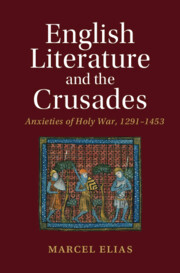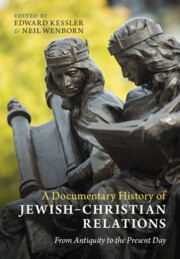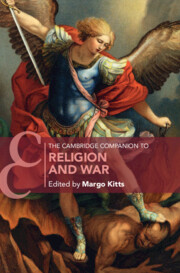Refine search
Actions for selected content:
46 results

The Cambridge Guide to Global Medieval Travel Writing
-
- Published online:
- 03 October 2025
- Print publication:
- 02 October 2025
Chapter 6 - Globalising Whiteness
- from Part I - Contexts
-
-
- Book:
- The Cambridge Guide to Global Medieval Travel Writing
- Published online:
- 03 October 2025
- Print publication:
- 02 October 2025, pp 104-126
-
- Chapter
- Export citation
Chapter 11 - Iceland
- from The Nordic World and the British Isles
-
-
- Book:
- The Cambridge Guide to Global Medieval Travel Writing
- Published online:
- 03 October 2025
- Print publication:
- 02 October 2025, pp 203-216
-
- Chapter
- Export citation
Chapter 2 - The Crusades
- from Part I - Contexts
-
-
- Book:
- The Cambridge Guide to Global Medieval Travel Writing
- Published online:
- 03 October 2025
- Print publication:
- 02 October 2025, pp 40-56
-
- Chapter
- Export citation
19 - The Military Papacy
- from Part IV - Theopolitics and Religious Diplomacy
-
-
- Book:
- The Cambridge History of the Papacy
- Published online:
- 28 February 2025
- Print publication:
- 20 March 2025, pp 499-518
-
- Chapter
- Export citation
2 - The Invention of European Honorable Surrender during the Age of Chivalry
-
- Book:
- Leaving the Fight
- Published online:
- 01 March 2025
- Print publication:
- 06 February 2025, pp 32-66
-
- Chapter
- Export citation
Crusade, Politics, and Pastoral Care in the Klosterneuburg Sermons of 1467
-
- Journal:
- Austrian History Yearbook / Volume 56 / May 2025
- Published online by Cambridge University Press:
- 13 January 2025, pp. 13-31
- Print publication:
- May 2025
-
- Article
- Export citation
13 - Latin Christendom in the Later Middle Ages
-
-
- Book:
- The Cambridge History of Strategy
- Published online:
- 06 January 2025
- Print publication:
- 09 January 2025, pp 271-291
-
- Chapter
- Export citation
11 - Byzantine Strategy (ad 630–1204)
-
-
- Book:
- The Cambridge History of Strategy
- Published online:
- 06 January 2025
- Print publication:
- 09 January 2025, pp 226-250
-
- Chapter
- Export citation
Introduction
-
- Book:
- English Literature and the Crusades
- Published online:
- 17 October 2024
- Print publication:
- 31 October 2024, pp 1-17
-
- Chapter
- Export citation

English Literature and the Crusades
- Anxieties of Holy War, 1291–1453
-
- Published online:
- 17 October 2024
- Print publication:
- 31 October 2024
4 - The Medieval Period
- from Part II - 900 to 1800
-
-
- Book:
- A Documentary History of Jewish–Christian Relations
- Published online:
- 03 October 2024
- Print publication:
- 17 October 2024, pp 185-232
-
- Chapter
- Export citation

A Documentary History of Jewish–Christian Relations
- From Antiquity to the Present Day
-
- Published online:
- 03 October 2024
- Print publication:
- 17 October 2024
Chapter 18 - Decolonizing the Medieval Literary Curriculum
- from Part IV - Canon Revisions
-
-
- Book:
- Decolonizing the English Literary Curriculum
- Published online:
- 02 November 2023
- Print publication:
- 09 November 2023, pp 349-366
-
- Chapter
-
- You have access
- Open access
- HTML
- Export citation
11 - Islam and the Just War Tradition
- from Part II - Just War
-
-
- Book:
- The Cambridge Companion to Religion and War
- Published online:
- 04 May 2023
- Print publication:
- 11 May 2023, pp 255-268
-
- Chapter
- Export citation
Chapter 3 - Court and Cloister in Aquitaine and Occitania
-
- Book:
- Medieval Polyphony and Song
- Published online:
- 27 April 2023
- Print publication:
- 11 May 2023, pp 33-55
-
- Chapter
- Export citation

The Cambridge Companion to Religion and War
-
- Published online:
- 04 May 2023
- Print publication:
- 11 May 2023
6 - Multilingualism and the Attitude toward French in the Latin Kingdom of Jerusalem
-
-
- Book:
- Multilingualism and History
- Published online:
- 20 April 2023
- Print publication:
- 27 April 2023, pp 123-137
-
- Chapter
- Export citation
5 - Reawakening of Intellectual Life in the Middle Ages
- from Part I - Psychology’s Historical Foundations
-
- Book:
- History and Systems of Psychology
- Published online:
- 04 November 2022
- Print publication:
- 17 November 2022, pp 87-107
-
- Chapter
- Export citation
